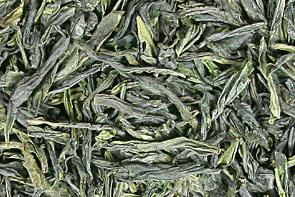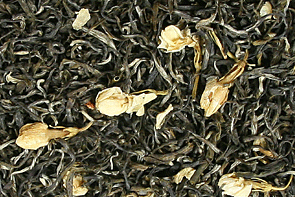Steeping Green Tea
China Spring Green Tea (pre-Qing Ming and Yu Qian ‘Before the Rain’ teas) and Japan Ichibancha 1st Pluck Spring Green Tea
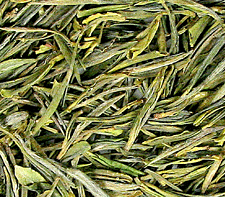
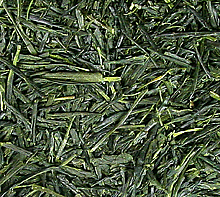
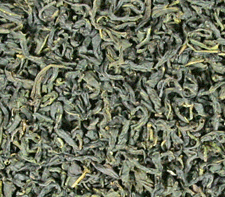
- First: measure the capacity of your teapot Fill your teapot with water to its ‘functional capacity’ (the practical level at which it will pour without the contents spilling out from the body of the teapot; also allowing for the addition of the mass of the leaves) and then measure this volume of water in ounces. Divide this number by 6. Most recommendations for the amount of leaf tea to use are based on 6 ounces of water. For example, a 24-ounce teapot generally requires 4 measures of leaf tea to make a full-strength pot of liquid tea.
- Measure of tea: Chinese Green Tea use 2 to 3 grams (2 teaspoons to 2 Tablespoons) leaf per 6 ounces of water
- Measure of tea: Japanese Green Tea use 2 to 3 grams (1-1.5 teaspoons to 2-3 teaspoons) leaf per 4 ounces of water
- Water temperature: use water that is 170°F – 180°F
Asian description: ‘column of steam steadily rising’ water. That’s when a column of steam begins to rise from the surface. Or boil the water and let it rest for three to four minutes.
It is critical that you use cooler water when steeping first-of-the-spring-season green tea such as Chinese pre-Qing Ming and Yu Qian early spring green teas, and Japanese 1st Pluck Ichibancha spring green teas. Tender leaves can scorch if exposed to water that is too hot, producing a bitter, astringent, and unpleasant cup of tea.
- Steeping time: keep the leaf in the water for the appropriate amount of time
Green tea leaves are rarely ‘in the water’ for longer than 2 minutes at a time ( often less ), so start with a 2 minute steep, and taste a tea that is ‘new to you’ every 30 seconds after.
Green tea leaves can be steeped again, usually 2 to 3 times, depending on the tea, at the same or a slightly hotter water temperature than what was used for the initial steeping. (Japanese teas are often re-steeped in cooler water!)
There are many flavor nuances that can be discovered by adjusting the length of time when steeping green tea. Try both longer and shorter steeping times and see which you prefer.
Green Tea: China Late Spring, Main Harvest, and Autumnal Tea; & China Jasmine Tea
- First: measure the capacity of your teapot Fill your teapot with water to its ‘functional capacity’ (the practical level at which it will pour without the contents spilling out from the body of the teapot; also allowing for the addition of the mass of the leaves) and then measure this volume of water in ounces. Divide this number by 6. Most recommendations for the amount of leaf tea to use are based on 6 ounces of water. For example, a 24-ounce teapot generally requires 4 measures of leaf tea to make a full-strength pot of liquid tea.
- Measure of tea: use 2 to 3 grams (2 teaspoons to 2 Tablespoons) leaf per 6 ounces of water
Green tea leaf varies more by volume to weight than any other class of tea except white tea. Some green teas are comprised of large leaves, others have small leaves. Some green teas are light and fluffy, others are rolled, twisted and dense. Our recommendation for how much to use for each of our green teas may surprise you, but they are all measured by us, to deliver delicious taste.
Chinese green teas are more varied in appearance and size than are the Japanese and Korean green teas, which are generally more uniform in shape and size, and most often will require approximately 1 to 2 teaspoons.
Once you learn to recognize a few basics about the firing-style and shaping-style used in the manufacture of the different China green teas, the quantity of green tea to use (measured by volume) will become easier to determine.
Jasmine teas are generally more uniform and can require 1.5 teaspoons to 1.25 Tablespoons for best flavor. The exception to this would be Silver Needles Jasmine, which is not a traditional Jasmine tea. It is much bulkier and should be steeped using our suggestions for the white tea Yin Zhen.
- Water temperature: use water that is 175 °F – 185°F
Asian description: ‘fish eyes’ water. That’s when large bubbles first appear – or boil the water and let it rest for three minutes.
- Steeping time: keep the leaf in the water for the appropriate amount of time.
Green tea leaves are rarely ‘in the water’ for longer than 2 minutes at a time ( often less ) so start with a 2 minute steep, and taste a tea that is ‘new to you’ every 30 seconds after.
Green tea leaves can be steeped again, usually 2 to 3 times, depending on the tea, at the same or a slightly hotter water temperature than that used for the initial steeping.
Jasmine tea can be steeped from 2 to 4 minutes depending on the amount of scenting desired in the tea liquor. If you prefer a higher scent, then use a short steep time; if you prefer less scent, then steep the tea for a longer amount of time. Jasmine tea will re-steep; however, the floral aromatics in the cup of tea will be diminished after the initial steeping.
There are many flavor nuances that can be discovered by adjusting the length of time when steeping all of these types of tea. Try both longer or shorter steeping times and see which you prefer.
View our Selection of Green Tea View our Selection of Jasmine Tea
More tea steeping information: Steeping Black tea, Steeing Oolong tea, Steeping Pu-erh & Hei Cha, Steeping White tea, Steeping Yellow tea, Making Matcha

